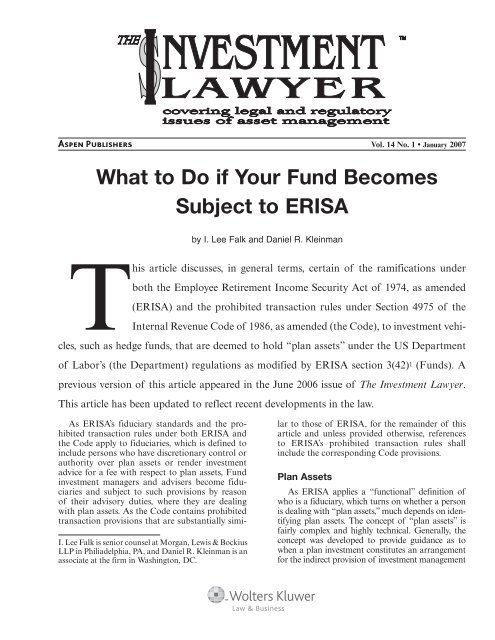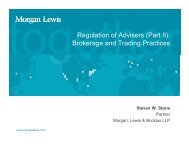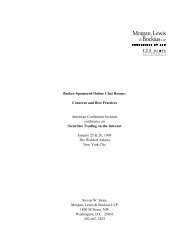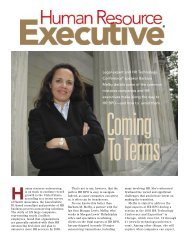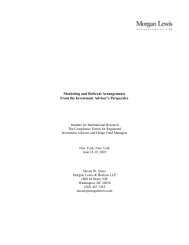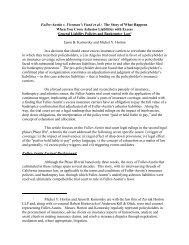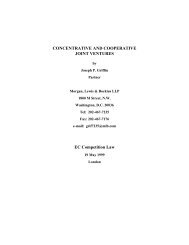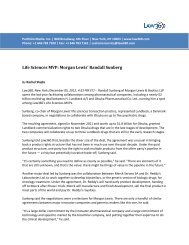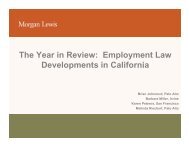What to Do if Your Fund Becomes Subject to ERISA - Morgan, Lewis ...
What to Do if Your Fund Becomes Subject to ERISA - Morgan, Lewis ...
What to Do if Your Fund Becomes Subject to ERISA - Morgan, Lewis ...
You also want an ePaper? Increase the reach of your titles
YUMPU automatically turns print PDFs into web optimized ePapers that Google loves.
<strong>What</strong> <strong>to</strong> <strong>Do</strong> <strong>if</strong> <strong>Your</strong> <strong>Fund</strong> <strong>Becomes</strong><br />
<strong>Subject</strong> <strong>to</strong> <strong>ERISA</strong><br />
As <strong>ERISA</strong>’s fiduciary standards and the prohibited<br />
transaction rules under both <strong>ERISA</strong> and<br />
the Code apply <strong>to</strong> fiduciaries, which is defined <strong>to</strong><br />
include persons who have discretionary control or<br />
authority over plan assets or render investment<br />
advice for a fee with respect <strong>to</strong> plan assets, <strong>Fund</strong><br />
investment managers and advisers become fiduciaries<br />
and subject <strong>to</strong> such provisions by reason<br />
of their advisory duties, where they are dealing<br />
with plan assets. As the Code contains prohibited<br />
transaction provisions that are substantially simi-<br />
by I. Lee Falk and Daniel R. Kleinman<br />
This article discusses, in general terms, certain of the ram<strong>if</strong>ications under<br />
both the Employee Retirement Income Security Act of 1974, as amended<br />
(<strong>ERISA</strong>) and the prohibited transaction rules under Section 4975 of the<br />
Internal Revenue Code of 1986, as amended (the Code), <strong>to</strong> investment vehi-<br />
cles, such as hedge funds, that are deemed <strong>to</strong> hold “plan assets” under the US Department<br />
of Labor’s (the Department) regulations as mod<strong>if</strong>ied by <strong>ERISA</strong> section 3(42) 1 (<strong>Fund</strong>s). A<br />
previous version of this article appeared in the June 2006 issue of The Investment Lawyer.<br />
This article has been updated <strong>to</strong> reflect recent developments in the law.<br />
I. Lee Falk is senior counsel at <strong>Morgan</strong>, <strong>Lewis</strong> & Bockius<br />
LLP in Philiadelphia, PA, and Daniel R. Kleinman is an<br />
associate at the firm in Washing<strong>to</strong>n, DC.<br />
lar <strong>to</strong> those of <strong>ERISA</strong>, for the remainder of this<br />
article and unless provided otherwise, references<br />
<strong>to</strong> <strong>ERISA</strong>’s prohibited transaction rules shall<br />
include the corresponding Code provisions.<br />
Plan Assets<br />
Vol. 14 No. 1 • January 2007<br />
As <strong>ERISA</strong> applies a “functional” definition of<br />
who is a fiduciary, which turns on whether a person<br />
is dealing with “plan assets,” much depends on ident<strong>if</strong>ying<br />
plan assets. The concept of “plan assets” is<br />
fairly complex and highly technical. Generally, the<br />
concept was developed <strong>to</strong> provide guidance as <strong>to</strong><br />
when a plan investment constitutes an arrangement<br />
for the indirect provision of investment management
services, as opposed <strong>to</strong> an investment in an entity with<br />
the purpose of generating profits through its operations.<br />
In other words, this provides a “look-through”<br />
rule for applying <strong>ERISA</strong> <strong>to</strong> certain entities that are<br />
not themselves employee benefit plans. If an entity<br />
is deemed <strong>to</strong> hold plan assets, each <strong>ERISA</strong> plan (or<br />
plan within the meaning of Code section 4975) that<br />
invests in such entity is deemed <strong>to</strong> hold an undivided<br />
interest in its underlying assets, and the managers<br />
of the entity generally will be considered fiduciaries<br />
for purposes of applying the prohibition transaction<br />
rules and <strong>ERISA</strong>’s fiduciary requirements.<br />
First, <strong>ERISA</strong> section 401(b)(1) provides that<br />
where a plan invests in securities issued by investment<br />
companies registered under the Investment<br />
Company Act of 1940, as amended (1940 Act)<br />
the assets of the plan include such securities<br />
but not the assets of the investment company.<br />
Second, <strong>ERISA</strong> section 401(b)(2) provides that<br />
plan assets include a plan’s investment in certain<br />
types of insurance contracts but not the assets of<br />
the insurer. By negative implication, other entities<br />
that are not spec<strong>if</strong>ically carved out by the statute<br />
do hold plan assets.<br />
To clar<strong>if</strong>y the definition of plan assets and provide<br />
guidance as <strong>to</strong> how <strong>to</strong> ident<strong>if</strong>y entities that<br />
hold plan assets, the Department adopted its “plan<br />
assets regulation.” As stated in the preamble <strong>to</strong> the<br />
plan assets regulation, the regulation “reflect[s] a<br />
general policy determination that the fiduciary<br />
responsibility provisions of [<strong>ERISA</strong>] should apply<br />
<strong>to</strong> an entity in which a plan invests only <strong>if</strong>: (1) the<br />
plan’s investment is such that it has an opportunity<br />
<strong>to</strong> participate in the earnings of the entity;<br />
(2) the entity itself is an investment fund; and (3)<br />
there is some indication that interests in the entity<br />
are offered especially <strong>to</strong> plans.” 2<br />
As noted, the “plan assets” concept is a lookthrough<br />
rule. The plan assets regulation provides<br />
that an entity will be deemed <strong>to</strong> hold plan assets <strong>if</strong>:<br />
• The plan’s investment is an “equity interest;”<br />
• The investment is not a “publicly-offered<br />
security;”<br />
• The issuer is not registered as an investment<br />
company under the 1940 Act;<br />
• The issuer is not an “operating company;”<br />
and<br />
• Equity participation by “benefit plan inves<strong>to</strong>rs”<br />
is “sign<strong>if</strong>icant.”<br />
THE INVESTMENT LAWYER 2<br />
Although some unregistered investment funds,<br />
such as private equity and real estate funds, can<br />
avoid being deemed <strong>to</strong> hold plan assets by qual<strong>if</strong>ying<br />
as special types of operating companies under<br />
the plan assets regulation, known as VCOCs for<br />
“venture capital operating companies” or REOCs<br />
for “real estate operating companies,” which each<br />
require a certain level of management authority<br />
over their portfolio investments, most unregistered<br />
funds that avoid holding plan assets do so by<br />
ensuring that participation by benefit plan inves<strong>to</strong>rs<br />
remains insign<strong>if</strong>icant. In short, the plan asset<br />
regulation provides that participation by benefit<br />
plan inves<strong>to</strong>rs is not sign<strong>if</strong>icant where benefit plan<br />
inves<strong>to</strong>rs own less than 25 percent in value of each<br />
class of equity interest in the investment fund (the<br />
so-called 25 percent rule). Shares owned by the<br />
fund’s investment manager, adviser, or any affiliate<br />
thereof (or any other person with discretionary<br />
authority or control over the investment of the<br />
fund’s assets or a person who provides the fund<br />
investment advice for a fee) are disregarded from<br />
such calculation. The calculation is done each<br />
time fund shares are issued or redeemed.<br />
As so much depends on how the 25 percent<br />
rule is calculated, Congress, after much lobbying,<br />
stepped in <strong>to</strong> clar<strong>if</strong>y the rule. The Pension<br />
Protection Act of 2006 (PPA), enacted August<br />
17, 2006, adds section 3(42) <strong>to</strong> <strong>ERISA</strong> in order<br />
<strong>to</strong> mod<strong>if</strong>y the Department’s plan asset regulation.<br />
Spec<strong>if</strong>ically, <strong>ERISA</strong> section 3(42) redefines “benefit<br />
plan inves<strong>to</strong>r” <strong>to</strong> include only<br />
1. <strong>ERISA</strong> covered employee benefit plans,<br />
2. Tax-qual<strong>if</strong>ied retirement plans and accounts<br />
(such as KEOGH plans and IRAs) that are<br />
subject <strong>to</strong> the Code’s prohibited transaction<br />
rules and<br />
3. Other entities (such as a hedge funds or a feeder<br />
fund in a master-feeder structure) whose<br />
underlying assets are deemed <strong>to</strong> be plan assets<br />
under the plan asset regulation as mod<strong>if</strong>ied<br />
by <strong>ERISA</strong> section 3(42) (collectively, <strong>ERISA</strong>/<br />
Code plans).<br />
The sign<strong>if</strong>icance of the change is in what the<br />
term “benefit plan inves<strong>to</strong>r” no longer includes.<br />
Spec<strong>if</strong>ically, prior <strong>to</strong> the enactment of <strong>ERISA</strong><br />
section 3(42), the term “benefit plan inves<strong>to</strong>r” for<br />
purposes of the plan asset regulation included in<br />
addition <strong>to</strong> <strong>ERISA</strong>/Code plans, retirement plans<br />
neither covered by <strong>ERISA</strong> nor subject <strong>to</strong> the<br />
Code’s prohibited transaction rules, such as governmental,<br />
foreign and non-electing church plans.<br />
As these non-<strong>ERISA</strong>/Code plans are no longer
considered benefit plan inves<strong>to</strong>rs, their investments<br />
are no long aggregated with the investments of the<br />
<strong>ERISA</strong>/Code for purposes of calculating the 25<br />
percent rule, resulting in greater capacity for funds<br />
choosing <strong>to</strong> remain under the 25 percent rule.<br />
The PPA also clar<strong>if</strong>ies that in the context of<br />
a fund of funds, master-feeder or other situation<br />
where one private investment fund invests in<br />
another, the investing fund that holds plan assets<br />
only holds plan assets <strong>to</strong> the extent of its benefit<br />
plan inves<strong>to</strong>rs. Prior <strong>to</strong> the PPA, it was generally<br />
believed <strong>to</strong> be all or nothing. Thus, an underlying<br />
investment fund would generally count 100<br />
percent of the investment by an entity deemed <strong>to</strong><br />
hold plan assets under the 25 percent rule, regardless<br />
of whether benefit plan inves<strong>to</strong>rs made up 26<br />
percent of the fund’s inves<strong>to</strong>rs or 96 percent. After<br />
the PPA, it is clear that the underlying fund, when<br />
calculating its 25 percent test, must only consider<br />
as plan assets that proportion of an entity’s investment,<br />
when such entity exceeds the 25 percent rule,<br />
attributable <strong>to</strong> its benefit plan inves<strong>to</strong>rs. Under the<br />
PPA, the extent <strong>to</strong> which an inves<strong>to</strong>r is exposed <strong>to</strong><br />
benefit plan inves<strong>to</strong>rs is important <strong>to</strong> the underlying<br />
fund in calculating its benefit plan inves<strong>to</strong>r<br />
percentage and lines of communications between<br />
the underlying and investing funds will have <strong>to</strong> be<br />
established <strong>to</strong> accurately track such percentages,<br />
which could change upon the acquisitions and<br />
redemptions of interests in either fund.<br />
As the 25 percent rule is a fairly mechanical test,<br />
hedge fund investment managers have his<strong>to</strong>rically<br />
used feeder funds, clone funds and other structural<br />
devices and configurations, such as forced<br />
redemptions and conversions of equity interests<br />
<strong>to</strong> debt interests, <strong>to</strong> “manage” compliance with<br />
the 25 percent rule. However, with the enactment<br />
of the PPA, the use of these types of structural<br />
devices and configurations may <strong>to</strong> a large extent<br />
be unnecessary.<br />
If the <strong>Fund</strong> is deemed <strong>to</strong> hold plan assets, the<br />
<strong>Fund</strong>’s investment manager will be deemed <strong>to</strong> be<br />
an <strong>ERISA</strong> fiduciary, subject <strong>to</strong> <strong>ERISA</strong>’s standard<br />
of care and prohibited transaction rules, with<br />
respect <strong>to</strong> each <strong>ERISA</strong> inves<strong>to</strong>r and constitute a<br />
fiduciary under the Code’s prohibited transaction<br />
rules with respect <strong>to</strong> tax-qual<strong>if</strong>ied retirement plans<br />
and accounts that are not otherwise subject <strong>to</strong><br />
<strong>ERISA</strong>’s fiduciary provisions.<br />
Fiduciary Duties and Standards<br />
As an <strong>ERISA</strong> plan fiduciary, the <strong>Fund</strong>’s investment<br />
manager is required <strong>to</strong> discharge its duties<br />
with respect <strong>to</strong> each <strong>ERISA</strong> plan inves<strong>to</strong>r: (1)<br />
solely in the interest of the plan’s participants; (2)<br />
for the exclusive purpose of providing benefits <strong>to</strong><br />
the plan’s participants and defraying reasonable<br />
plan expenses; (3) with the care, skill, prudence<br />
and diligence under the circumstances then prevailing<br />
that a prudent man acting in a like capacity<br />
and familiar with such matters would use in<br />
the conduct of an enterprise of a like character<br />
and with like aims (the so-called prudent expert<br />
standard); (4) by divers<strong>if</strong>ying investments of the<br />
plan assets so as <strong>to</strong> minimize the risk of large<br />
losses, unless under the circumstances it is clearly<br />
prudent not <strong>to</strong> do so; and (5) in accordance with<br />
the governing plan documents and instruments,<br />
insofar as they are consistent with the provisions<br />
of <strong>ERISA</strong>. Additionally, the <strong>Fund</strong> is required <strong>to</strong><br />
maintain the indicia of ownership of all <strong>ERISA</strong><br />
plan assets within the jurisdiction of the courts of<br />
the United States and the investment manager, as<br />
a fiduciary, will also have <strong>to</strong> meet <strong>ERISA</strong>’s bonding<br />
requirement.<br />
<strong>ERISA</strong> fiduciary standards require the investment<br />
manager <strong>to</strong> act prudently and the prohibited<br />
transaction provisions, as discussed more fully<br />
below, will generally prohibit, absent an applicable<br />
exemption, transactions between the <strong>Fund</strong> and<br />
the investment manager (or its affiliates), as well<br />
as other third parties who provide services <strong>to</strong> or<br />
otherwise have a relationship with the investing<br />
<strong>ERISA</strong> Plan. In the event of a breach of fiduciary<br />
duty, <strong>ERISA</strong> subjects fiduciaries <strong>to</strong> personal liability<br />
for losses and disgorgement of profits earned<br />
from such breach. <strong>ERISA</strong> also voids, as against<br />
public policy, certain exculpa<strong>to</strong>ry provisions, such<br />
as indemn<strong>if</strong>ication from plan assets, for losses<br />
attributable <strong>to</strong> breaches of fiduciary duty. Thus,<br />
indemn<strong>if</strong>ication and standard of care provisions<br />
contained in a <strong>Fund</strong>’s offering documents should<br />
be drafted with these limits in mind.<br />
Prohibited Transactions<br />
In order <strong>to</strong> safeguard the financial integrity of<br />
retirement assets, <strong>ERISA</strong> and the Code prohibit,<br />
absent an applicable exemption, certain persons,<br />
including fiduciaries, service providers, sponsoring<br />
employers, unions representing covered employees<br />
and certain of their affiliates (referred <strong>to</strong> as a<br />
party-in-interest for purposes of <strong>ERISA</strong>’s provisions<br />
or “disqual<strong>if</strong>ied persons” for purposes of the<br />
Code’s provisions), from engaging in certain transactions<br />
with the plan. Spec<strong>if</strong>ically, a fiduciary is<br />
prohibited from knowingly (or where the fiduciary<br />
should have known) entering in<strong>to</strong> a transaction<br />
with plan assets that constitute a direct or indirect:<br />
Vol. 14, No. 1 • January 2007
(A) sale or exchange, or leasing, of any property<br />
between the plan and a party in interest; (B) lending<br />
of money or other extension of credit between<br />
the plan and a party in interest; (C) furnishing of<br />
goods, services or facilities between the plan and a<br />
party in interest; (D) transfer <strong>to</strong>, or use by or for<br />
the benefit of, a party in interest, of any asset of<br />
the plan; or (E) acquisition, on behalf of the plan,<br />
of any employer security or employer real property<br />
in violation of <strong>ERISA</strong> section 407(a).<br />
The prohibited transaction rules further prohibit<br />
a fiduciary: (1) from dealing with the assets of<br />
the plan in its own interest or for its own account<br />
(that is, self-dealing), (2) from in its individual or<br />
in any other capacity acting in any transaction<br />
involving the plan on behalf of a party (or represent<br />
a party) whose interests are adverse <strong>to</strong> the<br />
interests of the plan or the interests of its participants<br />
or beneficiaries, 3 or (3) from receiving any<br />
consideration for its own personal account from<br />
any party dealing with such plan in connection<br />
with a transaction involving the assets of the plan<br />
(that is, kickbacks).<br />
Violation of the prohibited transaction rules<br />
will generally require the unwinding of the transaction<br />
(that is, offering recession rights, disgorgement,<br />
etc.) and subject the parties involved in the<br />
transaction <strong>to</strong> an excise tax of 15 percent of the<br />
amount involved for each year the transaction<br />
continues regardless of whether the party in interest<br />
knew or should have known that the transaction<br />
was prohibited. The Code also imposes an<br />
additional 100 percent excise tax <strong>if</strong> the prohibited<br />
transaction remains uncorrected for 90 days after<br />
the mailing by the Internal Revenue Service of a<br />
notice of deficiency for the initial tax.<br />
<strong>ERISA</strong>’s prohibited transaction provisions are,<br />
however, subject <strong>to</strong> a number of exemptions.<br />
These prohibited transaction exemptions take<br />
one of three forms: the statu<strong>to</strong>ry exemptions<br />
contained in <strong>ERISA</strong> and the Code; Prohibited<br />
Transaction Class Exemptions or “PTEs” that are<br />
granted by the Department, which can be relied<br />
on for any transaction that meets the required<br />
conditions; and individual prohibited transaction<br />
exemptions that are granted by the Department<br />
and can only be relied upon by the party requesting<br />
such exemption.<br />
Delegation of Investment Duties<br />
Under <strong>ERISA</strong>, where an <strong>ERISA</strong> plan permits<br />
it, the authority <strong>to</strong> manage, acquire, or<br />
dispose of plan assets may be delegated by the<br />
<strong>ERISA</strong> plan’s named fiduciaries (generally the<br />
THE INVESTMENT LAWYER 4<br />
plan sponsor or committee thereof) <strong>to</strong> one or<br />
more investment advisers. In such case, <strong>if</strong> the<br />
investment adviser qual<strong>if</strong>ies as an “investment<br />
manager” under <strong>ERISA</strong> (Investment Manager),<br />
the trustees of the <strong>ERISA</strong> plan will not be responsible<br />
for the day-<strong>to</strong>-day management of the plan’s<br />
assets placed under the control of the Investment<br />
Manager, and the trustees generally will not be<br />
liable for the actions of the Investment Manager.<br />
To qual<strong>if</strong>y as an Investment Manager, the investment<br />
adviser must be either: (1) registered as a<br />
investment adviser under the Investment Advisers<br />
Act of 1940, as amended, or, in certain cases,<br />
with one or more state securities authorities, (2)<br />
a federally or state supervised bank, or (3) an<br />
insurance company qual<strong>if</strong>ied <strong>to</strong> perform investment<br />
management services under the laws of more<br />
than one state. Also, the investment adviser must<br />
acknowledge its fiduciary responsibilities <strong>to</strong> the<br />
plan in writing. If the investment adviser does not<br />
qual<strong>if</strong>y as an Investment Manager, the trustee of<br />
the investing <strong>ERISA</strong> plan will retain co-fiduciary<br />
responsibility with respect <strong>to</strong> the acts and omissions<br />
of the investment adviser. Conversely, where<br />
an Investment Manager is properly appointed, the<br />
plan’s trustees will not be held responsible for the<br />
acts and omissions of the Investment Manager,<br />
however, the appointing plan fiduciary will be<br />
responsible for the fiduciary decision <strong>to</strong> appoint<br />
the Investment Manager and will remain obligated<br />
<strong>to</strong> moni<strong>to</strong>r such appointment on an on-going<br />
basis <strong>to</strong> ensure that it remains prudent and in the<br />
interests of the plan.<br />
As the proper delegation of investment responsibility<br />
directly affects the trustees’ liability exposure,<br />
the documentation of these appointments<br />
can be a point of important negotiation from the<br />
standpoint of an investing plan. Thus, a detailed<br />
discussion of the appointment in the offering documents,<br />
spec<strong>if</strong>ically drafted <strong>to</strong> address this issue,<br />
may aid a plan fiduciary in deciding <strong>to</strong> invest in<br />
a <strong>Fund</strong>. In short, plan fiduciaries (and their legal<br />
counsel) may view a <strong>Fund</strong> investment more like<br />
the hiring of an investment manager than the purchase<br />
of a security and may feel more comfortable<br />
in the process <strong>if</strong> they believe the manager is familiar<br />
with <strong>ERISA</strong> and the regula<strong>to</strong>ry issues that the<br />
plan fiduciaries generally operate within.<br />
Spec<strong>if</strong>ic Issues of Concern When<br />
Dealing with Plan Assets<br />
Described below are some of the more common<br />
types of transactions for <strong>Fund</strong>s and <strong>Fund</strong> managers<br />
and the issues they raise under the prohibited
transaction rules. The list is by no means intended<br />
<strong>to</strong> be comprehensive.<br />
Transactions Between the Investment Manager<br />
(and Its Affiliates) and the Plan<br />
Absent an exemption, almost any transaction<br />
between a plan (or its assets) and the <strong>Fund</strong>’s<br />
investment manager or other party-in-interest (or<br />
any affiliate thereof) is a prohibited transaction.<br />
For instance, the borrowing of securities from a<br />
person who is a party-in-interest <strong>to</strong> a plan that<br />
invests in a <strong>Fund</strong> is, absent an exemption, a prohibited<br />
transaction. Two commonly used exemptions<br />
or exceptions include:<br />
Blind Transactions<br />
The general prohibition against the buying and<br />
selling of an asset between a party-in-interest and<br />
a plan does not apply <strong>to</strong> ordinary “blind” securities<br />
transactions engaged in through a broker<br />
where neither the buyer nor the seller is aware of<br />
the identity of the other. The PPA cod<strong>if</strong>ies and<br />
generally expands this doctrine. 4 Sign<strong>if</strong>icantly,<br />
the PPA no longer requires the restriction on the<br />
knowledge of the identity of the parties. This<br />
exemption should cover most exchange transactions.<br />
Thus, equity trades done on an exchange<br />
or through an electronic communication network<br />
(ECN) or alternative trading system (ATS) will<br />
not constitute a prohibited transaction <strong>if</strong> the following<br />
conditions are met:<br />
• The cost and compensation associated with<br />
the transaction is no greater than that of an<br />
arm’s length transaction;<br />
• Either (1) the transaction is effected pursuant<br />
<strong>to</strong> rules designed <strong>to</strong> match purchases and<br />
sales at the best price available or (2) neither<br />
the execution system nor the parties <strong>to</strong> the<br />
transaction take in<strong>to</strong> account the identity of<br />
the parties in the execution of trades;<br />
• If the party in interest has an ownership<br />
interest in the execution system, a plan fiduciary,<br />
independent of the party in interest,<br />
must authorize the transaction; and<br />
• Not less than 30 days prior <strong>to</strong> the initiation<br />
of such transactions, a plan fiduciary is provided<br />
written or electronic notice of the use<br />
of the trading system.<br />
As this exemption only applies with respect <strong>to</strong><br />
the purchase or sale, transactions in fixed income<br />
securities provide another dimension that this<br />
exemption does not cover, that is, the extension<br />
of credit between the issuer who may be a partyin-interest<br />
and the investing plan. However, when<br />
available, the QPAM exemption, discussed next,<br />
and/or the new Service Provider exemption added<br />
by the PPA may cover both the purchase or sale<br />
and the extension of credit.<br />
QPAM Exemption<br />
For transactions that do not fall within the<br />
“blind transaction” exception, <strong>Fund</strong>s may try<br />
<strong>to</strong> avail themselves of PTE 84-14 (the so-called<br />
QPAM Exemption), which exempts most transactions<br />
between a <strong>Fund</strong> and any person who is<br />
a party-in-interest <strong>to</strong> any plan that invests in the<br />
<strong>Fund</strong>. It is unclear with the new Service Provider<br />
exemption, discussed below, <strong>if</strong> and <strong>to</strong> what extent<br />
<strong>Fund</strong>s will need <strong>to</strong> rely upon the QPAM exemption<br />
in the future. Nevertheless, the QPAM exemption,<br />
subject <strong>to</strong> certain limited exceptions, helps<br />
the investment manager avoid prohibited transactions<br />
in its dealing, on behalf of the <strong>Fund</strong>, with a<br />
person who is a party-in-interest <strong>to</strong> a plan invested<br />
in the <strong>Fund</strong>. Where the exemption applies, it does<br />
not matter <strong>if</strong> the investment manager knows that<br />
the other party is such a party-in-interest or not.<br />
This exemption is extremely important because<br />
a large plan can easily have thousands of parties-in-interest,<br />
which change all of the time. For<br />
example, the investment manager, on behalf of the<br />
<strong>Fund</strong>, may purchase bonds issued by a corporation<br />
that provides services <strong>to</strong> a plan invested in the<br />
<strong>Fund</strong>. Absent the QPAM exemption (or the new<br />
Service Provider exemption) and assuming the<br />
corporation does not fall in<strong>to</strong> the limited class of<br />
parties-in-interest not covered by the exemption,<br />
as discussed more fully below, this transaction<br />
would constitute a prohibited transaction as an<br />
extension of credit between a plan and a party-ininterest<br />
and may also constitute a purchase or sale<br />
between a plan and a party-in-interest.<br />
To be covered under the QPAM exemption, the<br />
transaction must be entered in<strong>to</strong> under the discretionary<br />
authority of a “qual<strong>if</strong>ied professional<br />
asset manager,” or “QPAM.” The investment<br />
manager 5 will qual<strong>if</strong>y as a QPAM so long as (i)<br />
it is a federally registered investment adviser; (ii)<br />
it has <strong>to</strong>tal client assets under its discretionary<br />
management in excess of $85 million as of the last<br />
day of its fiscal year; (iii) it has either shareholders’<br />
or partners’ equity in excess of $1 million; and<br />
(iv) neither it nor any five percent or more owner<br />
Vol. 14, No. 1 • January 2007
has, within the prior 10 years, been convicted (or<br />
released from prison, <strong>if</strong> later) of a broad range of<br />
felonies. The QPAM exemption will cover almost<br />
all transactions except:<br />
• Transactions with the QPAM or any of its<br />
affiliates;<br />
• Transactions with a party-in-interest (or an<br />
affiliate thereof) who has the authority <strong>to</strong><br />
either appoint or terminate the investment<br />
manager as a QPAM with respect <strong>to</strong> the<br />
plan or negotiate the terms of the management<br />
agreement with the QPAM (including<br />
renewals or mod<strong>if</strong>ications thereof) on behalf<br />
of the plan;<br />
• Securities lending by the <strong>Fund</strong> (covered by a<br />
separate exemption, see below);<br />
• Acquisitions of interests in mortgage pools<br />
(covered by a separate exemption);<br />
• Residential mortgage financing (covered by<br />
a separate exemption);<br />
• Transactions involving any <strong>ERISA</strong> plan<br />
when the assets of the plan managed by the<br />
QPAM constitute more than 20 percent of<br />
the QPAM’s <strong>to</strong>tal assets under management<br />
(not 20 percent of the <strong>Fund</strong>’s assets).<br />
As the excise tax for entering in<strong>to</strong> a prohibited<br />
transaction will fall on the party-in-interest that<br />
engages in the transaction, reliance on the QPAM<br />
exemption is generally key <strong>to</strong> managing exposure<br />
<strong>to</strong> many types of inadvertent prohibited transactions.<br />
Therefore, when QPAM is <strong>to</strong> be relied on,<br />
the investment manager should require, as part of<br />
the <strong>Fund</strong>’s offering documents, that each investing<br />
plan ident<strong>if</strong>y and maintain an up-<strong>to</strong>-date list<br />
of those parties-in-interest for which the QPAM<br />
exemption will not be available (that is, those<br />
parties-in-interest vested with the authority <strong>to</strong><br />
hire and terminate the QPAM). For purposes of<br />
the QPAM exemption and subject a 10 percent<br />
de minimis exception for plans invested in commingled<br />
investment funds, the ability <strong>to</strong> cause a<br />
redemption from a <strong>Fund</strong> managed by the QPAM<br />
is deemed the authority <strong>to</strong> terminate the QPAM.<br />
New Service Provider Exemption<br />
The PPA includes a new Service Provider exemption<br />
for a broad array of transactions between a<br />
plan and its service providers (other than those<br />
THE INVESTMENT LAWYER<br />
who are fiduciaries with respect <strong>to</strong> the assets<br />
involved in the transaction). Covered transactions<br />
include sales or exchanges, leases, and extensions<br />
of credit. This exemptions is similar <strong>to</strong> the QPAM<br />
exemption, without many of the stringent QPAM<br />
conditions as described above. The exemption<br />
applies only when the plan receives no less, nor<br />
pays no more, than “adequate consideration.”<br />
Adequate consideration is defined as:<br />
• In the case of a security for which there is<br />
a generally recognized market, either (A)<br />
the prevailing price on a national securities<br />
exchange (taking in<strong>to</strong> account fac<strong>to</strong>rs such<br />
as transaction size and security marketability)<br />
or (B) <strong>if</strong> not traded on a national<br />
security exchange, a price not less favorable<br />
<strong>to</strong> the plan (taking in<strong>to</strong> account fac<strong>to</strong>rs such<br />
as transaction size and security marketability)<br />
than the offering price for the security as<br />
established by current bid and asked prices<br />
quoted by persons independent of both<br />
the security issuer and the party in interest<br />
claiming the exemption, and<br />
• In the case of assets other than a security for<br />
which there is a generally recognized market,<br />
the fair market value of the asset as determined<br />
in good faith by a plan fiduciary in<br />
accordance with regulations <strong>to</strong> be prescribed<br />
by the DOL.<br />
As the ultimate determination as <strong>to</strong> whether or<br />
not the adequate consideration requirement is met,<br />
especially with respect <strong>to</strong> off-market transactions,<br />
will be a factual issue, delegating fiduciaries and<br />
transaction counterparties may feel more comfortable<br />
relying on the QPAM exemption. However, as<br />
the Department develops regulations as <strong>to</strong> how <strong>to</strong><br />
determine fair market value under this exemption,<br />
its broad scope may become very useful in providing<br />
advisory services with respect <strong>to</strong> plan assets.<br />
Incentive Fees<br />
Although neither <strong>ERISA</strong> nor the Code spec<strong>if</strong>ically<br />
addresses the issue of incentive fees, a fee<br />
arrangement pursuant <strong>to</strong> which a <strong>Fund</strong>’s investment<br />
manager (or its affiliate) is compensated<br />
based on the investment performance of the <strong>Fund</strong><br />
may result in a prohibited transaction. To the<br />
extent that incentive fees permit the <strong>Fund</strong> investment<br />
manager <strong>to</strong> control the timing or amount<br />
of the incentive fee or otherwise encourages the
manager <strong>to</strong> make investment decisions that are<br />
not in the best interests of the investing plans, in<br />
an attempt <strong>to</strong> maximize its compensation, such<br />
fees could result in a non-exempt prohibited transaction.<br />
The Department has issued a number of advisory<br />
opinions permitting incentive fee arrangements<br />
where the following conditions were present:<br />
• The arrangements complied with Securities<br />
and Exchange Commission Rule 205-3<br />
governing incentive compensation arrangements;<br />
• Performance was measured by a formula<br />
taking in<strong>to</strong> account both realized and unrealized<br />
gains and losses during a pre-established<br />
valuation period no shorter than one<br />
year;<br />
• A large majority of the investments would<br />
be made in securities with readily available<br />
market quotations, and those that weren’t<br />
would be independently valued by persons<br />
appointed by the plan and independent of<br />
the investment manager;<br />
• Execution of the arrangement was allowed<br />
only for plans having aggregate assets of at<br />
least $50 million;<br />
• The arrangement must be approved by an<br />
independent fiduciary for each plan involved<br />
in the transaction;<br />
• The arrangement must be terminable by a<br />
plan “on reasonably short notice under the<br />
circumstances;” and<br />
• The <strong>to</strong>tal compensation paid <strong>to</strong> the investment<br />
manager will in no case exceed reasonable<br />
compensation for services performed.<br />
We are aware that some <strong>Fund</strong>s have gone below<br />
the $50 million threshold in the Advisory<br />
Opinions. The key point <strong>to</strong> emphasize is that<br />
the fiduciary approving the investment and fee<br />
arrangement must be sophisticated with respect<br />
<strong>to</strong> such issues.<br />
Execution of Securities Transactions<br />
The following four points should be made<br />
regarding the execution of securities transactions.<br />
7<br />
Principal Transactions<br />
In general, <strong>if</strong> the <strong>Fund</strong>’s investment manager<br />
(or an affiliate thereof) engages in a purchase or<br />
sale transaction with a <strong>Fund</strong> acting as a principal,<br />
the transaction will constitute a prohibited<br />
transaction for which there is no statu<strong>to</strong>ry or class<br />
exemption available.<br />
Agency Transactions—Reimbursement<br />
of Direct Expenses<br />
If the <strong>Fund</strong>’s investment manager directs agency<br />
brokerage transactions <strong>to</strong> itself or an affiliate, a prohibited<br />
transaction will generally not occur <strong>if</strong> the<br />
brokerage services are provided on an agency basis<br />
for no additional consideration other than reimbursement<br />
of direct (out-of-pocket) expenses (for<br />
example, costs of unaffiliated clearing brokers).<br />
Affiliated Brokerage— PCE 86-128<br />
The Department issued PTE 86-128 under<br />
which an adviser can utilize the services of an<br />
affiliated broker and the receipt of brokerage fees<br />
from plan accounts for effecting securities transactions<br />
will not be prohibited as long as the broker<br />
does not engage in “churning.” Please note that<br />
the underlying investment strategy will be taken<br />
in<strong>to</strong> account in determining whether a broker is<br />
churning. In addition, the following conditions<br />
must be met:<br />
1. Prior and continuing approval of an independent<br />
fiduciary is obtained for each plan<br />
involved in the transaction.<br />
2. Not less than 30 days prior <strong>to</strong> implementation<br />
of the arrangement or any material change<br />
there<strong>to</strong>, the independent fiduciary must receive<br />
any reasonably available information that the<br />
broker/fiduciary seeking authorization believes<br />
<strong>to</strong> be necessary for the independent fiduciary<br />
<strong>to</strong> make an informed approval. Such disclosure<br />
must include a description of the broker’s<br />
“brokerage placement practices.” “Brokerage<br />
placement practices” refers <strong>to</strong> policies regarding<br />
soft dollars, etc. This requirement can<br />
generally be satisfied by providing brokerage<br />
placement practice disclosures in the manner<br />
required by Form ADV under the Investment<br />
Advisers Act.<br />
3. The independent fiduciary’s authorization is<br />
terminable at will. The affected <strong>ERISA</strong> Plan<br />
must be given a reasonable opportunity <strong>to</strong><br />
withdraw from a <strong>Fund</strong>.<br />
4. After trading commences, the independent<br />
fiduciary must be provided with respect <strong>to</strong><br />
each trade of the <strong>Fund</strong>:<br />
Vol. 14, No. 1 • January 2007
• Confirmation of each trade, or at least once<br />
every three months, a summary of all trades;<br />
• A summary report, at least once per year<br />
and not more than 45 days after the end of the<br />
reporting period, containing:<br />
— All securities transaction-related charges<br />
paid pursuant <strong>to</strong> PTCE 86-128;<br />
— A breakdown of charges retained<br />
by the fiduciary (and its affiliates) and the<br />
charges paid <strong>to</strong> third parties;<br />
— A revised description of the broker’s<br />
placement practices, <strong>if</strong> they have materially<br />
changed; and<br />
— A portfolio turnover ratio, which is a<br />
rough test for churning. For this purpose,<br />
PTCE 86-128 prescribes a safe harbor in<br />
the form of an “annualized portfolio turn<br />
over ratio” calculation.<br />
As PTE 86-128 contains d<strong>if</strong>ferent conditions<br />
for pooled investment vehicles that commingle the<br />
assets of more than one plan, additional conditions<br />
will apply <strong>to</strong> separately managed accounts<br />
and <strong>Fund</strong>s wholly owned by a single plan.<br />
PTE 86-128 also covers, subject <strong>to</strong> certain additional<br />
conditions, agency cross-trades (i.e., transactions<br />
in which the same person acts as agent for<br />
both seller and buyer for the purchase or sale of<br />
a security) where the person (including its affiliates)<br />
effecting the trade has discretion (or provides<br />
investment advice) with respect <strong>to</strong> such trade for<br />
either the buyer or the seller but not both.<br />
Direct Cross-Trades<br />
The PPA contains a long awaited prohibited<br />
transaction exemption for direct cross-trades (that<br />
is, when the manager has discretion on both sides<br />
of the trade). For purposes of this exemption,<br />
cross-trade means the trading of securities between<br />
a “large plan” and another account managed by<br />
the same adviser who meets the definition of an<br />
“investment manager” under <strong>ERISA</strong> or the Code.<br />
As adopted, this exemption is only available for<br />
large plans (meaning plans with assets of or part<br />
of a master trust with assets of $100 million or<br />
more), thus there remains a number of questions<br />
as <strong>to</strong> how it is <strong>to</strong> be applied, <strong>if</strong> at all, <strong>to</strong> <strong>Fund</strong>s.<br />
Moreover, <strong>if</strong> this exemption is available <strong>to</strong> <strong>Fund</strong>s,<br />
it is also unclear whether the <strong>Fund</strong> needs <strong>to</strong> meet<br />
the $100 million limit or <strong>if</strong> each plan investing<br />
therein needs <strong>to</strong> separately meet the limit. In addition,<br />
the following conditions must be met:<br />
1. The transaction is a purchase or sale for no<br />
consideration other than cash payment against<br />
THE INVESTMENT LAWYER<br />
prompt delivery of a security for which market<br />
quotations are available;<br />
2. The transaction is effected at the independent<br />
current market price of the security;<br />
3. No brokerage commission, fee (except certain<br />
cus<strong>to</strong>mary transfer fees, where certain advance<br />
disclosures are made) or other remuneration is<br />
paid in connection with the transaction;<br />
4. A plan fiduciary independent of the investment<br />
manager authorizes, in advance and in<br />
a document separate from any other written<br />
agreements of the parties, the ability of the<br />
investment manager <strong>to</strong> conduct such crosstrades;<br />
5. The investment manager provides the plan<br />
fiduciary written disclosure, in a separate<br />
writing, of the conditions under which crosstrades<br />
can occur;<br />
6. The investment manager provides the plan<br />
quarterly reports detailing all cross-trades<br />
executed in the quarter;<br />
7. The investment manager does not condition<br />
its fees on the use of cross-trades or charge a<br />
higher fee where the plan fiduciary refuses <strong>to</strong><br />
permit cross-trades under this exemption;<br />
8. The investment manager has adopted certain<br />
written cross-trading policies and procedures 6<br />
that provide for the allocation of cross-trades<br />
among participating accounts in an objective<br />
manner; and<br />
9. The investment manager shall designate an<br />
individual responsible for periodically reviewing<br />
cross-trades <strong>to</strong> ensure that they were<br />
conducted in conformity with the manager’s<br />
policies and procedures and <strong>to</strong> cert<strong>if</strong>y, under<br />
penalty of perjury, <strong>to</strong> the plan fiduciary, such<br />
person’s findings and conclusions.<br />
In addition <strong>to</strong> this new relief, PTE 2002-12 permits,<br />
under certain limited circumstances, direct<br />
cross-trades that result from certain index/modeldriven<br />
portfolios (that is, passive cross-trades) or<br />
certain large account portfolio restructurings.<br />
Securities Borrowing/Lending<br />
Affiliates. The <strong>Fund</strong>’s investment manager may<br />
not lend or borrow <strong>Fund</strong> securities <strong>to</strong> or from<br />
affiliates.<br />
Lending. The <strong>Fund</strong>’s investment manager may<br />
lend <strong>Fund</strong> securities <strong>to</strong> unaffiliated persons in two<br />
circumstances: (i) the other party is not a party<br />
in interest <strong>to</strong> any <strong>ERISA</strong> plan that invests in the<br />
<strong>Fund</strong>, or (ii) prohibited transaction class exemption<br />
81-6 applies. The first exception is normally
handled through a combination of due diligence<br />
on the part of the investment manager and representations<br />
and warranties from the other party.<br />
With respect <strong>to</strong> the representations and warranties,<br />
as the QPAM exemption is generally not<br />
available for securities lending transactions, it<br />
would be appropriate for the manager <strong>to</strong> obtain<br />
from each investing plan a list of known banks<br />
and broker-dealers that are parties-in-interest<br />
<strong>to</strong> such plans <strong>to</strong> ensure that the borrower is not<br />
a party-in-interest <strong>to</strong> such plans. Alternatively,<br />
the manager could get a representation for the<br />
borrower that it is not such a party-in-interest,<br />
but given how broad the term party-in-interest<br />
is defined and how consolidated the financial<br />
services industry is becoming, borrowers do not<br />
provide such a representation easily. Nevertheless,<br />
most securities lending arrangements involving<br />
plan assets are structured <strong>to</strong> meet the conditions<br />
of PTE 81-6, which permits the lending of plan<br />
assets <strong>to</strong> a party-in-interest where the exemption’s<br />
conditions are met.<br />
Borrowing. The investment manager, on behalf<br />
of the <strong>Fund</strong>, may generally borrow securities from<br />
any person who is not a party-in-interest and may<br />
even be able <strong>to</strong> borrow from a party-in-interest <strong>if</strong><br />
the QPAM exemption is met.<br />
Investments in Other <strong>Fund</strong>s<br />
of the Investment Manager<br />
As the prohibited transaction rules prevent<br />
a fiduciary from using its fiduciary authority <strong>to</strong><br />
hire itself (or an affiliate) <strong>to</strong> provide an additional<br />
service <strong>to</strong> a plan for an additional fee, the investment<br />
of <strong>Fund</strong> assets by the investment manager<br />
in<strong>to</strong> another investment vehicle affiliated with the<br />
investment manager is problematic. For example,<br />
the investment of cash reserves of the <strong>Fund</strong> in<br />
a mutual fund that is advised by the investment<br />
manager (or its affiliates) is a prohibited transaction.<br />
However, the Department has promulgated<br />
PTE 77-4 for the express purpose of permitting<br />
an adviser, where the applicable conditions of<br />
the exemption are met, <strong>to</strong> invest plan assets in<br />
the adviser’s affiliated mutual fund. It is important<br />
<strong>to</strong> note that PTE 77-4 is only available for<br />
investments in open-end investment companies<br />
registered under the 1940 Act. For investments<br />
in other than mutual funds, there are a number<br />
approaches that may be utilized <strong>to</strong> address the<br />
<strong>ERISA</strong> and prohibited transaction issues that<br />
arise with investments in affiliated funds where<br />
PTE 77-4 is not available. Furthermore, it is noted<br />
that PTE 77-4 does not relieve the fiduciary of its<br />
basic fiduciary and standard of care with regard<br />
<strong>to</strong> the investment.<br />
Organizational and Operating Expenses<br />
While charging the <strong>Fund</strong> with organizational<br />
and operating expenses for services rendered by<br />
unrelated outside service providers affiliated with<br />
the investment manager does not generally present<br />
a problem, the payment by the <strong>Fund</strong> of expenses<br />
resulting from the engagement of service providers<br />
that are affiliated with the investment manager may<br />
result in a prohibited transaction. To the extent that<br />
the investment manager (or its affiliates are entitled<br />
<strong>to</strong> reimbursement) from a <strong>Fund</strong> for expenses, the<br />
foregoing rules limit such reimbursement <strong>to</strong> “direct<br />
expenses.” This generally includes out-of-pocket<br />
payments for taxes, insurance, brokerage commissions,<br />
fees of outside audi<strong>to</strong>rs, etc., but not (i) payment<br />
for any item already reasonably included within<br />
the scope of the services for which fees are being<br />
paid (for example, <strong>if</strong> the investment manager were<br />
<strong>to</strong> hire a subadviser <strong>to</strong> assist it, generally it would<br />
have <strong>to</strong> do so at its own expense); or (ii) expenses<br />
that are normally includible in overhead (for example.,<br />
the cost of a new computer terminal dedicated<br />
<strong>to</strong> the <strong>Fund</strong>) or otherwise fixed (for example, any<br />
part of the salary of an existing employee who<br />
assists with the <strong>Fund</strong>). Furthermore, all expenses,<br />
regardless of whether they are paid <strong>to</strong> third-parties<br />
or the investment manager (or its affiliate), must<br />
also be reasonable in amount and for a service or<br />
product that is necessary for the operation of the<br />
<strong>Fund</strong> and the plans invested therein.<br />
Employer Securities<br />
No more than 10 percent of the assets of a<br />
defined benefit pension plan may be invested in<br />
qual<strong>if</strong>ying securities of the plan’s sponsor (including<br />
its affiliates). Because many defined benefit<br />
plans operate very close <strong>to</strong> this limit, a <strong>Fund</strong>’s<br />
purchase of securities of the plan’s sponsor (or<br />
affiliates thereof) that is invested in the <strong>Fund</strong><br />
could cause this 10 percent limit <strong>to</strong> be exceeded.<br />
A procedure should be put in place <strong>to</strong> ensure that<br />
the <strong>Fund</strong> does not invest (or limits investments) in<br />
securities of the sponsors (and their affiliates) of<br />
plans invested in the <strong>Fund</strong>.<br />
Correction Period for Certain Transactions<br />
Involving Securities and Commodities<br />
The PPA provides a new mechanism for correcting<br />
securities or commodities transactions<br />
Vol. 14, No. 1 • January 2007
that inadvertently violate the non-fiduciary prohibited<br />
transaction rules under <strong>ERISA</strong> or the<br />
Code. Spec<strong>if</strong>ically, the PPA permits the correction,<br />
within a 14-day correction period, of certain securities<br />
or commodities transaction. The relief only<br />
applies <strong>to</strong> the non-fiduciary prohibited transaction<br />
rules (that is, it does not apply <strong>to</strong> instances<br />
of fiduciary self-dealing, breaches of loyalty or<br />
the receipt of kickbacks). Moreover, it neither<br />
applies <strong>to</strong> transactions between a plan and a plan<br />
sponsor with respect <strong>to</strong> the purchase or sale of an<br />
employer security or the acquisition, sale or lease<br />
of any employer property, nor transactions where<br />
the fiduciary or other party in interest knew or<br />
reasonably should have known that the transaction<br />
would constitute a non-exempt prohibited<br />
transaction.<br />
To qual<strong>if</strong>y for this exemption, (1) the transaction<br />
must be undone <strong>to</strong> the extent possible, (2) the<br />
plan must be made whole for any losses resulting<br />
from the transaction, and (3) profits made by the<br />
party in interest through the use of the plan’s<br />
assets must be res<strong>to</strong>red <strong>to</strong> the plan. The correction<br />
must be completed by the end of the 14-day<br />
correction period which starts on the day that the<br />
fiduciary either discovers, or reasonably should<br />
have discovered, that the transaction would constitute<br />
a non-exempt prohibited transaction under<br />
<strong>ERISA</strong> section 406(a) or the corresponding provisions<br />
under the Code.<br />
As many of the inadvertent non-fiduciary prohibited<br />
transactions covered by this exemption<br />
will occur with respect <strong>to</strong> a party in interest who<br />
is a party in interest by virtue of being a service<br />
provider (that is, the purchase by a plan of a bond<br />
issued by a plan service provider), many of the<br />
potential transactions that this provision would<br />
have been helpful in addressing prior <strong>to</strong> the PPA<br />
may already be exempt under the Service Providers<br />
exemption discussed above. Furthermore, the<br />
use of the subjective “should have known” and<br />
“should have discovered” standards may cause<br />
much uncertainty with respect <strong>to</strong> relying upon this<br />
exemption.<br />
UBTI<br />
As plan trusts are tax exempt for federal<br />
income tax purposes they are exposed <strong>to</strong> potential<br />
taxation under the unrelated business taxable<br />
income (UBTI) rules of the Code. Thus, certain<br />
types of income (such as debt-financed income),<br />
when passed through <strong>to</strong> a tax-exempt inves<strong>to</strong>r<br />
results in UBTI and requires such inves<strong>to</strong>r <strong>to</strong><br />
file a federal income tax return for such taxable<br />
THE INVESTMENT LAWYER 10<br />
income and <strong>to</strong> pay such tax. Although incurring<br />
UBTI by a tax-exempt inves<strong>to</strong>r is not prohibited<br />
by the Code, it does lower investment returns by<br />
the applicable tax and many plan trustees try, <strong>to</strong><br />
the extent possible, <strong>to</strong> limit or otherwise avoid<br />
UBTI entirely as a matter of policy. Thus, when<br />
structuring <strong>Fund</strong>s that will target plan inves<strong>to</strong>rs,<br />
recognizing the potential for generating UBTI is<br />
a key fac<strong>to</strong>r.<br />
Other Considerations<br />
<strong>Fund</strong> Offering <strong>Do</strong>cuments<br />
Unlike securities laws, proper disclosure does<br />
not generally prevent or cure a prohibited transaction<br />
or breach of fiduciary duty under <strong>ERISA</strong> or<br />
the Code. Accordingly, certain contractual provisions<br />
that are generally standard for investment<br />
funds that do not hold plan assets may not be permitted<br />
or otherwise enforceable for a <strong>Fund</strong>. The<br />
investment manager may not, for example, be able<br />
<strong>to</strong> enforce the following provisions <strong>if</strong> the <strong>Fund</strong>’s<br />
assets are deemed <strong>to</strong> be plan assets:<br />
• Provisions that require a <strong>Fund</strong> <strong>to</strong> pay the<br />
legal fees of a general partner of a <strong>Fund</strong>.<br />
Such payment may not be permissible <strong>if</strong> a<br />
suit involves a claim of breach of fiduciary<br />
duty on the part of the general partner.<br />
• Provisions permitting certain conflicts of<br />
interest. These provisions may violate the<br />
investment manager’s fiduciary duty <strong>to</strong> the<br />
<strong>ERISA</strong> plan inves<strong>to</strong>rs.<br />
• Provisions permitting the investment manager<br />
<strong>to</strong> “bunch” the <strong>Fund</strong>’s orders for the<br />
purchase and sale of securities with orders<br />
submitted on behalf of other advisory<br />
accounts managed by the investment manager.<br />
In certain circumstances (for example,<br />
always delaying the <strong>ERISA</strong> plan’s trades),<br />
this could cause a breach of fiduciary duty.<br />
• Provisions providing the investment manager<br />
with sign<strong>if</strong>icant flexibility in valuing <strong>Fund</strong><br />
assets. As mentioned, it will be necessary <strong>to</strong><br />
have valuations of certain assets conducted<br />
by independent parties where incentive fee<br />
arrangements are utilized.<br />
• Provisions, as mentioned above, purporting<br />
<strong>to</strong> relieve an <strong>ERISA</strong> fiduciary from<br />
its fiduciary responsibilities under <strong>ERISA</strong>.<br />
Accordingly, any indemnity from a <strong>Fund</strong> <strong>to</strong>
the <strong>Fund</strong>’s fiduciary for breaches of fiduciary<br />
duty will have no legal effect.<br />
Bonding<br />
<strong>ERISA</strong> fiduciaries must generally be bonded,<br />
unless an exception is available. The PPA added<br />
a new exemption for registered broker-dealers<br />
subject <strong>to</strong> the fidelity bonding requirements of<br />
an SRO (self-regula<strong>to</strong>ry organization). Absent<br />
an exception, the amount of the bond is calculated<br />
by plan and must be in the amount of at<br />
least 10 percent of the amount of <strong>ERISA</strong> funds<br />
“handled,” but not more than $500,000. The PPA<br />
also increases the maximum bond amount <strong>to</strong><br />
$1,000,000, for plans holding employer securities,<br />
effective for plan years after December 31, 2007.<br />
It is currently unclear as <strong>to</strong> how this increase will<br />
apply <strong>to</strong> fiduciaries that either do not handle<br />
employer securities at all or handle de minimums<br />
amounts of employer securities as a manager of<br />
a <strong>Fund</strong> (that is, securities held as part of an S&P<br />
500 fund). Although not required, many plan<br />
trustees will also require <strong>Fund</strong> managers <strong>to</strong> maintain<br />
minimum amounts of errors and omission<br />
insurance.<br />
Reporting<br />
Each <strong>ERISA</strong> Plan must file an annual report<br />
with the Department that includes a statement of<br />
11<br />
all plan assets. If <strong>Fund</strong> assets include plan assets,<br />
then each investing plan’s proportionate share of<br />
all <strong>Fund</strong> assets must be reported. As an alternative,<br />
the <strong>Fund</strong> may file a report directly with the<br />
Department as a “direct filing entity,” reducing the<br />
plan’s reporting obligation <strong>to</strong> only reporting its<br />
ownership interest in the direct filing entity.<br />
NOTES<br />
1. <strong>ERISA</strong> section 3(42) was added as part of the Pension<br />
Protection Act of 2006, which was signed in<strong>to</strong> law on August<br />
17, 2006.<br />
2. 51 Fed. Reg. 41263.<br />
3. This provision is applicable <strong>to</strong> <strong>ERISA</strong> fiduciaries only and<br />
is not included in the Code’s prohibited transaction rules.<br />
4. At the time of printing, there still remains a number of<br />
interpretative issues with this new PPA exemption, which<br />
should be addressed by technical corrections. These issues<br />
include the exemption’s application <strong>to</strong> national exchanges and<br />
situations where the fiduciary placing the trade is affiliated (that<br />
is, ownership interest) with the exchange, ECN, ATS or similar<br />
system.<br />
5. D<strong>if</strong>ferent requirements apply for banks, savings and loan<br />
associations, and insurance companies.<br />
6. No later than 180 days after the PPA’s enactment, the<br />
Department, after consultation with the Securities Exchange<br />
Commission, is required <strong>to</strong> issue regulations regarding the<br />
content of the policies and procedures <strong>to</strong> be adopted by the<br />
manager.<br />
Reprinted from Investment Lawyer, January 2007, Volume 14, Number 1, pages 18–28,<br />
with permission from Aspen Publishers, Inc., a Wolters Kluwer Law & Business, New York, NY,<br />
1-800-638-8437, www.aspenpublishers.com.<br />
Vol. 14, No. 1 • January 2007


